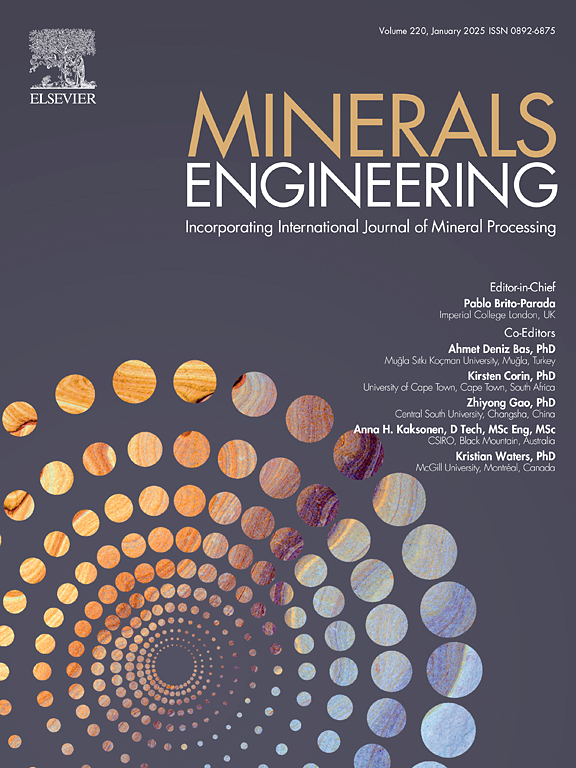The influence of NaCl on xanthate adsorption on chalcopyrite surface and chalcopyrite flotation
IF 4.9
2区 工程技术
Q1 ENGINEERING, CHEMICAL
引用次数: 0
Abstract
Due to freshwater scarcity, mineral flotation plants have been using alternative water resources including seawater together with water recycling, resulting in the accumulation of salts in process water. However, how salts affect the adsorption of xanthates on the surfaces of sulphide minerals and subsequent sulphide mineral flotation is unclear. To address the knowledge gap, this study investigated how NaCl affected the adsorption of potassium amyl xanthate (PAX) on chalcopyrite surface and chalcopyrite flotation. Cyclic voltammetry (CV) tests identified that NaCl increased the oxidation of PAX and its adsorption on chalcopyrite surface due to elevated ionic strength and electrical conductivity of water, facilitating charge transfer among PAX, chalcopyrite surface and oxygen. NaCl also increased chalcopyrite surface oxidation to produce more CuS, facilitating the formation of copper-xanthate complexes. Flotation tests identified that the increased adsorption of PAX by NaCl was only translated into improved true flotation of chalcopyrite at a low PAX concentration such as 50 ppm in NaCl solutions with low and medium concentrations (0.1 and 0.7 M, respectively). At a high PAX concentration such as 150 ppm, the coexistence of high concentrations of PAX and NaCl led to strong froth destabilisation, resulting in a dramatic reduction in water recovery and true flotation recovery of chalcopyrite. The findings from this study will be able to guide the flotation plants to maximise mineral flotation by choosing collector dosage based on the ionic strength of process water.
氯化钠对黄铜矿表面黄原酸盐吸附及黄铜矿浮选的影响
由于淡水匮乏,矿物浮选厂一直在使用替代水资源,包括海水和循环水,从而导致工艺水中盐分的积累。然而,盐类如何影响硫化矿物表面对黄原酸盐的吸附以及随后的硫化矿物浮选还不清楚。为了填补这一知识空白,本研究调查了氯化钠如何影响黄铜矿表面对戊基黄原酸钾(PAX)的吸附以及黄铜矿的浮选。循环伏安法(CV)测试发现,由于水的离子强度和电导率升高,促进了 PAX、黄铜矿表面和氧气之间的电荷转移,NaCl 增加了 PAX 的氧化及其在黄铜矿表面的吸附。氯化钠还增加了黄铜矿表面的氧化作用,产生更多的CuS,促进了黄铜酸铜络合物的形成。浮选测试表明,只有在 PAX 浓度较低时,如在中低浓度(分别为 0.1 和 0.7 兆欧)的 NaCl 溶液中为 50 ppm 时,NaCl 对 PAX 的吸附才会转化为黄铜矿的真正浮选。在 PAX 浓度较高时(如 150 ppm),高浓度 PAX 和 NaCl 的共存会导致强烈的泡沫不稳定,从而导致黄铜矿的水回收率和真正浮选回收率急剧下降。这项研究的结果将能够指导浮选厂根据工艺水的离子强度选择捕收剂用量,从而最大限度地提高矿物浮选率。
本文章由计算机程序翻译,如有差异,请以英文原文为准。
求助全文
约1分钟内获得全文
求助全文
来源期刊

Minerals Engineering
工程技术-工程:化工
CiteScore
8.70
自引率
18.80%
发文量
519
审稿时长
81 days
期刊介绍:
The purpose of the journal is to provide for the rapid publication of topical papers featuring the latest developments in the allied fields of mineral processing and extractive metallurgy. Its wide ranging coverage of research and practical (operating) topics includes physical separation methods, such as comminution, flotation concentration and dewatering, chemical methods such as bio-, hydro-, and electro-metallurgy, analytical techniques, process control, simulation and instrumentation, and mineralogical aspects of processing. Environmental issues, particularly those pertaining to sustainable development, will also be strongly covered.
 求助内容:
求助内容: 应助结果提醒方式:
应助结果提醒方式:


